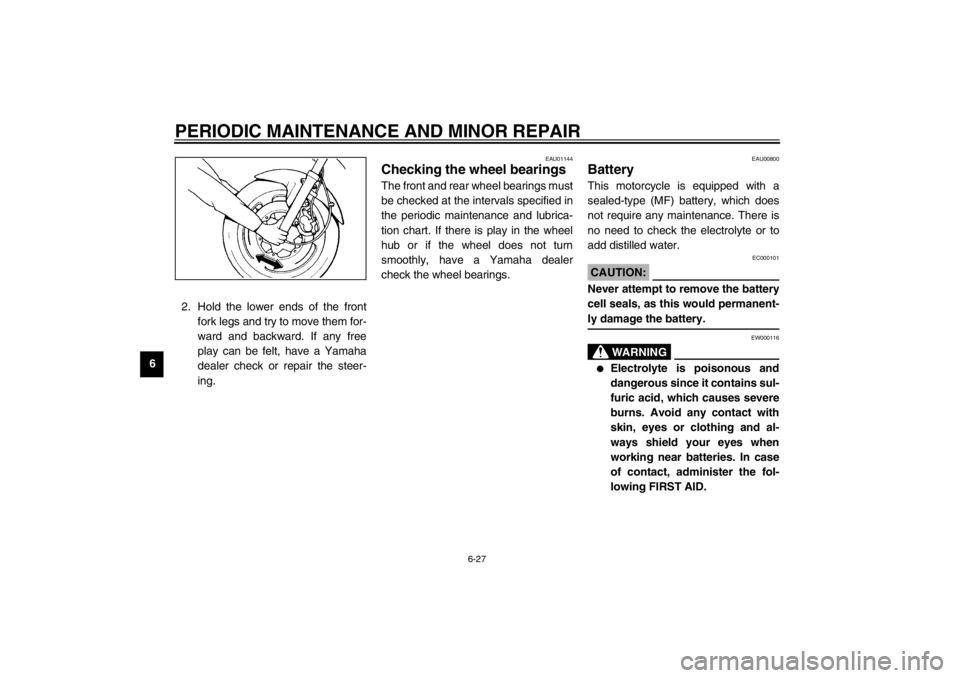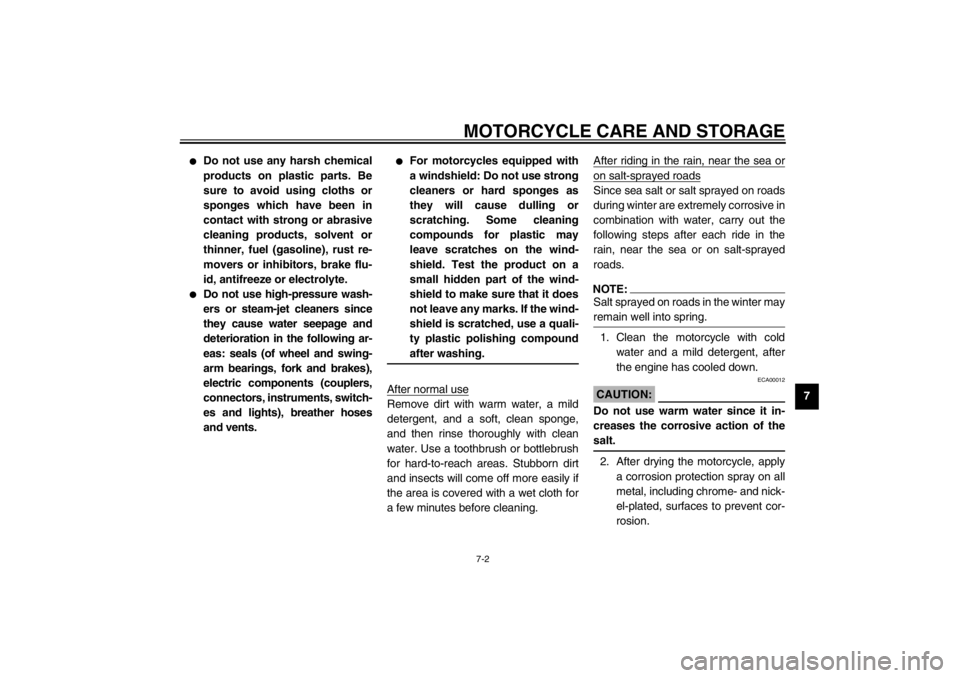Page 74 of 104

PERIODIC MAINTENANCE AND MINOR REPAIR
6-27
62. Hold the lower ends of the front
fork legs and try to move them for-
ward and backward. If any free
play can be felt, have a Yamaha
dealer check or repair the steer-
ing.
EAU01144
Checking the wheel bearings The front and rear wheel bearings must
be checked at the intervals specified in
the periodic maintenance and lubrica-
tion chart. If there is play in the wheel
hub or if the wheel does not turn
smoothly, have a Yamaha dealer
check the wheel bearings.
EAU00800
Battery This motorcycle is equipped with a
sealed-type (MF) battery, which does
not require any maintenance. There is
no need to check the electrolyte or to
add distilled water.
EC000101
CAUTION:@ Never attempt to remove the battery
cell seals, as this would permanent-
ly damage the battery. @
EW000116
WARNING
@ �
Electrolyte is poisonous and
dangerous since it contains sul-
furic acid, which causes severe
burns. Avoid any contact with
skin, eyes or clothing and al-
ways shield your eyes when
working near batteries. In case
of contact, administer the fol-
lowing FIRST AID.
E_4br.book Page 27 Wednesday, July 25, 2001 1:40 PM
Page 80 of 104

PERIODIC MAINTENANCE AND MINOR REPAIR
6-33
6
EAU00868
Front wheel To remove the front wheel
EW000122
WARNING
@ �
It is advisable to have a Yamaha
dealer service the wheel.
�
Securely support the motor-
cycle so that there is no danger
of it falling over.
@1. Place the motorcycle on the cen-
terstand.
2. Disconnect the speedometer ca-
ble from the front wheel.
3. Remove the brake calipers by re-
moving the bolts.
ECA00047
CAUTION:@ Do not pull the brake lever after the
brake caliper has been removed,
otherwise the brake pads will be
forced shut. @4. Loosen the front wheel axle pinch
bolt.
5. Pull the wheel axle out, and then
remove the wheel.
EAU04164
To install the front wheel
1. Install the speedometer gear unit
into the wheel hub so that the pro-
jections mesh with the slots.
2. Lift the wheel up between the fork
legs.NOTE:_ Make sure that the slot in the speedom-
eter gear unit fits over the retainer on
the fork leg. _3. Insert the wheel axle.
4. Take the motorcycle off the cen-
terstand so that the front wheel is
on the ground.
1. Speedometer cable
1. Front wheel axle
2. Front wheel axle pinch bolt
E_4br.book Page 33 Wednesday, July 25, 2001 1:40 PM
Page 81 of 104
PERIODIC MAINTENANCE AND MINOR REPAIR
6-34
6 5. Install the brake calipers by install-
ing the bolts.
NOTE:_ Make sure that there is enough space
between the brake pads before install-
ing the brake calipers onto the brake
discs. _6. Tighten the wheel axle, then the
front wheel axle pinch bolt, and the
brake caliper bolts to the specified
torques.7. Connect the speedometer cable.
8. Push down hard on the handlebar
several times to check for proper
fork operation.
Tightening torques:
Wheel axle:
58 Nm (5.8 m·kgf)
Front wheel axle pinch bolt:
40 Nm (4.0 m·kgf)
Brake caliper bolt:
19 Nm (1.9 m·kgf)
E_4br.book Page 34 Wednesday, July 25, 2001 1:40 PM
Page 82 of 104
PERIODIC MAINTENANCE AND MINOR REPAIR
6-35
6
EAU01480
Rear wheel To remove the rear wheel
EW000122
WARNING
@ �
It is advisable to have a Yamaha
dealer service the wheel.
�
Securely support the motor-
cycle so that there is no danger
of it falling over.
@1. Place the motorcycle on the
centerstand.
2. Remove the axle nut.3. Disconnect the brake torque rod
from the brake caliper bracket by
removing the nut and the bolt.4. While supporting the brake caliper
bracket, pull the wheel axle out.
5. Push the wheel forward, and then
remove the drive chain from the
rear sprocket.
NOTE:@ The drive chain does not need to be
disassembled in order to remove and
install the rear wheel. @6. Remove the wheel.
ECA00048
CAUTION:@ Do not apply the brake after the
wheel has been removed together
with the brake disc, otherwise the
brake pads will be forced shut. @
1. Rear wheel axle nut
1. Brake torque rod bolt
2. Nut
E_4br.book Page 35 Wednesday, July 25, 2001 1:40 PM
Page 83 of 104

PERIODIC MAINTENANCE AND MINOR REPAIR
6-36
6
EAU01468
To install the rear wheel
1. Insert the wheel axle from the
right-hand side.
2. Install the drive chain onto the rear
sprocket, and then adjust the drive
chain slack. (See page 6-21 for
drive chain slack adjustment pro-
cedures.)
3. Install the axle nut and brake
torque rod bolt at the brake caliper
bracket.
4. Install the brake caliper by install-
ing the bolts.NOTE:@ Make sure that there is enough space
between the brake pads before install-
ing the brake caliper onto the brake
disc. @5. Take the motorcycle off the cen-
terstand so that the rear wheel is
on the ground.
6. Tighten the axle nut and brake
torque rod bolt to the specified
torques.
EAU01008
Troubleshooting Although Yamaha motorcycles receive
a thorough inspection before shipment
from the factory, trouble may occur dur-
ing operation. Any problem in the fuel,
compression, or ignition systems, for
example, can cause poor starting and
loss of power.
The following troubleshooting chart
represents a quick and easy procedure
for checking these vital systems your-
self. However, should your motorcycle
require any repair, take it to a Yamaha
dealer, whose skilled technicians have
the necessary tools, experience, and
know-how to service the motorcycle
properly.
Use only genuine Yamaha replace-
ment parts. Imitation parts may look
like Yamaha parts, but they are often
inferior, have a shorter service life and
can lead to expensive repair bills. Tightening torques:
Axle nut:
105 Nm (10.5 m·kgf)
Brake torque rod bolt:
23 Nm (2.3 m·kgf)
E_4br.book Page 36 Wednesday, July 25, 2001 1:40 PM
Page 86 of 104

7-1
7
EAU03430
7-MOTORCYCLE CARE AND STORAGECare While the open design of a motorcycle
reveals the attractiveness of the tech-
nology, it also makes it more vulnera-
ble. Rust and corrosion can develop
even if high-quality components are
used. A rusty exhaust pipe may go un-
noticed on a car, however, it detracts
from the overall appearance of a
motorcycle. Frequent and proper care
does not only comply with the terms of
the warranty, but it will also keep your
motorcycle looking good, extend its life
and optimize its performance.Before cleaning
1. Cover the muffler outlets with plas-
tic bags after the engine has
cooled down.
2. Make sure that all caps and covers
as well as all electrical couplers
and connectors, including the
spark plug caps, are tightly in-
stalled.
3. Remove extremely stubborn dirt,
like oil burnt onto the crankcase,
with a degreasing agent and a
brush, but never apply such prod-
ucts onto seals, gaskets, sprock-
ets, the drive chain and wheel
axles. Always rinse the dirt and
degreaser off with water.Cleaning
ECA00010
CAUTION:@ �
Avoid using strong acidic wheel
cleaners, especially on spoked
wheels. If such products are
used on hard-to-remove dirt, do
not leave the cleaner on the af-
fected area any longer than in-
structed. Also, thoroughly rinse
the area off with water, immedi-
ately dry it, and then apply a
corrosion protection spray.
�
Improper cleaning can damage
windshields, cowlings, panels
and other plastic parts. Use
only a soft, clean cloth or
sponge with mild detergent and
water to clean plastic.
E_4br.book Page 1 Wednesday, July 25, 2001 1:40 PM
Page 87 of 104

MOTORCYCLE CARE AND STORAGE
7-2
7
�
Do not use any harsh chemical
products on plastic parts. Be
sure to avoid using cloths or
sponges which have been in
contact with strong or abrasive
cleaning products, solvent or
thinner, fuel (gasoline), rust re-
movers or inhibitors, brake flu-
id, antifreeze or electrolyte.
�
Do not use high-pressure wash-
ers or steam-jet cleaners since
they cause water seepage and
deterioration in the following ar-
eas: seals (of wheel and swing-
arm bearings, fork and brakes),
electric components (couplers,
connectors, instruments, switch-
es and lights), breather hoses
and vents.
�
For motorcycles equipped with
a windshield: Do not use strong
cleaners or hard sponges as
they will cause dulling or
scratching. Some cleaning
compounds for plastic may
leave scratches on the wind-
shield. Test the product on a
small hidden part of the wind-
shield to make sure that it does
not leave any marks. If the wind-
shield is scratched, use a quali-
ty plastic polishing compound
after washing.
@After normal useRemove dirt with warm water, a mild
detergent, and a soft, clean sponge,
and then rinse thoroughly with clean
water. Use a toothbrush or bottlebrush
for hard-to-reach areas. Stubborn dirt
and insects will come off more easily if
the area is covered with a wet cloth for
a few minutes before cleaning.After riding in the rain, near the sea or
on salt-sprayed roadsSince sea salt or salt sprayed on roads
during winter are extremely corrosive in
combination with water, carry out the
following steps after each ride in the
rain, near the sea or on salt-sprayed
roads.NOTE:@ Salt sprayed on roads in the winter may
remain well into spring. @1. Clean the motorcycle with cold
water and a mild detergent, after
the engine has cooled down.
ECA00012
CAUTION:@ Do not use warm water since it in-
creases the corrosive action of the
salt. @2. After drying the motorcycle, apply
a corrosion protection spray on all
metal, including chrome- and nick-
el-plated, surfaces to prevent cor-
rosion.
E_4br.book Page 2 Wednesday, July 25, 2001 1:40 PM
Page 90 of 104
MOTORCYCLE CARE AND STORAGE
7-5
77. Check and, if necessary, correct
the tire air pressure, and then lift
the motorcycle so that both of its
wheels are off the ground. Alterna-
tively, turn the wheels a little every
month in order to prevent the tires
from becoming degraded in one
spot.
8. Cover the muffler outlets with plas-
tic bags to prevent moisture from
entering them.
9. Remove the battery and fully
charge it. Store it in a cool, dry
place and charge it once a month.
Do not store the battery in an ex-
cessively cold or warm place (less
than 0 °C or more than 30 °C). For
more information on storing the
battery, see page 6-27.
NOTE:@ Make any necessary repairs before
storing the motorcycle. @E_4br.book Page 5 Wednesday, July 25, 2001 1:40 PM